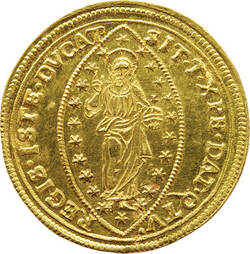For a long time, Venice was one of the leading maritime and trading powers in the Mediterranean. So it's not really surprising that the city's rulers minted a gold coin in 1284 – their first. It was called a "sequin" (or zecchino) and used the same images and legends unchanged for five hundred years. Until Napoleon occupied Venice in 1797 and the Great Council dissolved the Republic.
If you look at this coin, you can see the recurrent motif: it's Saint Mark, bestowing the city's banner (and hence the power to govern) on the doge, who kneels before him. The reverse shows the standing figure of Christ within a mandorla (an almond-shaped halo). The legend reads:
Sit tibi Christe datus quem tu regis iste ducatus, - "To thee, Christ, shall be given this dukedom, over which you reign."
The word DUCATUS means duchy, and that's where the name "ducat" originated. Ducats were among the most important European gold coins of the modern era. They weighed approximately 3.49 grammes.
However the one on display here weghs considerably more: 104.79 grammes – the equivalent of thirty ducats. From the legend, we know that the coin was struck by Doge Nicolò Contarini. He'd been elected doge at the advanced age of 77 on the 18th of January 1630, but died after only fifteen months in office. The prestigious style of the coin suggests it was specially issued to celebrate his taking office.
Further Media
- Location & Dating
- Venetia, n.d. (1630-1631)
- Material & Technique
- gold, embossed
- Dimenions
- Diameter: 47,3 mm; weight: 104,9 g
- Museum
- Münzkabinett
- Inventory number
- ATA722
